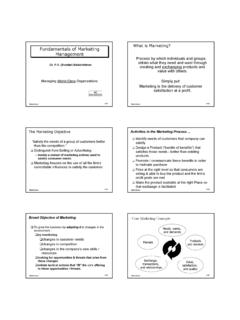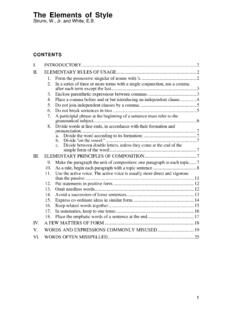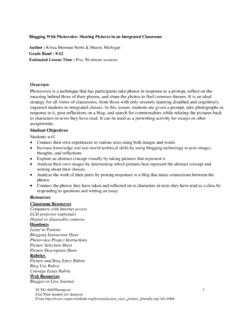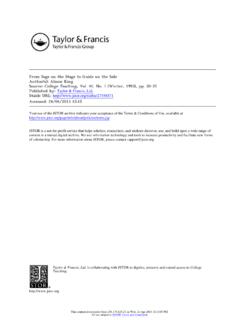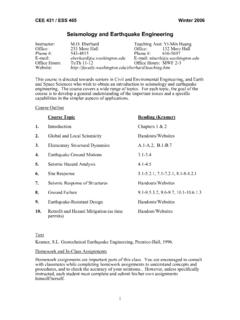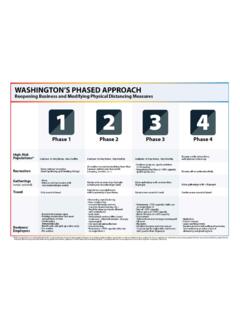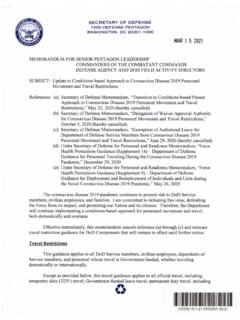Transcription of LECTURE 1. SYSTEMS DEVELOPMENT - University of …
1 I S 460 Notes Professor Yong Tan 1 LECTURE 1. SYSTEMS DEVELOPMENT INFORMATION SYSTEMS System A system is an interrelated set of business procedures used within one business unit working together for a purpose A system has nine characteristics A system exists within an environment A boundary separates a system from its environment Characteristics of a System Components Interrelated Components Boundary Purpose Environment Interfaces Constraints Input Output Information Technology Combination of computer technology (hardware and software) with telecommunications technology (data, image, and voice networks) Information SYSTEMS Turns data into information Includes: o Hardware and system software o Documentation and training materials o Job roles associated with the system o Controls to prevent theft or fraud o The people who use the software to perform their jobs SYSTEMS DEVELOPMENT LIFE CYCLE Major Attributes of the Lifecycle The project o Moves systematically through phases where each phase has a standard set of outputs o Produces project deliverables o Uses deliverables in implementation o Results in actual information system o Uses gradual refinement Project Phases Planning o Why build the system?
2 How should the team go about building it? o Identifying business value o Analyze feasibility o Develop work plan o Staff the project o Control and direct project Analysis I S 460 Notes Professor Yong Tan 2 o Who uses system, what will it do, where and when will the system be used? o Information gathering o Process modeling o Logic modeling o Data modeling Design o How will the system work? o Physical design o Architectural design o Interface design o Database and file design o Program design Implementation o System delivery o Construction Program building Program and system testing o Installation Conversion strategy Training plan Support plan o Operation System changed to reflect changing conditions System obsolescence SYSTEMS DEVELOPMENT Life Cycle Phases are not necessarily sequential o Sequential o Parallel Each phase has a specific outcome and deliverable Individual companies use customized life cycle Processes and Deliverables Planning o System Request o Feasibility Analysis o Workplan Analysis System Proposal Design System Specification Implementation New System and Maintenance Plan IMPLEMENTING SDLC Methodology A formalized approach to implementing the SDLC o A series of steps and deliverables Methodology Categories Category I
3 Category II Process Oriented Data Oriented Object Oriented Structured DEVELOPMENT Rapid Application DEVELOPMENT Agile DEVELOPMENT Waterfall DEVELOPMENT Methodology Structured I S 460 Notes Professor Yong Tan 3 Proceed in sequence from one phase to another Pros Identifies SYSTEMS requirements long before programming begins Minimizes changes to requirements as project progresses Cons Design must be specified on paper before programming begins Long time between system proposal and delivery of new system Parallel DEVELOPMENT Methodology General design Divide project into subprojects that are designed and implemented in parallel Final integration Pros o Reduces Schedule Time o Less Chance of rework Cons o Still uses paper documents o Sub-projects May Be Difficult to Integrate Rapid Application DEVELOPMENT Incorporate special techniques and tools: o Joint Application Design (JAD) Users, Managers and Analysts work together for several days System requirements are reviewed Structured meetings o CASE tools Automate or support drawing and analysis of system models Translate of system models into application programs CASE repository: system developers database for system models, detailed descriptions and specifications, and other products of system DEVELOPMENT Forward engineering: draw system models that are subsequently transformed into program code.
4 Reverse engineering: read existing program code and transform that code into a representative system model that can be edited and refined by the SYSTEMS analyst. o Fourth generation/visualization programming languages o Code generators Three RAD Categories o Phased DEVELOPMENT o A series of versions developed sequentially o Prototyping o System prototyping o Throw-away prototyping o Design prototyping Phased DEVELOPMENT Methodology o Break into a series of versions that are developed sequentially o Pros o User get a system to use quickly o User can identify additional needs for later versions o Cons o Users work with a system that is intentionally incomplete I S 460 Notes Professor Yong Tan 4 Prototyping o Building a scaled-down working version of the system o Concurrent analysis, design and implementation, repeated o Advantages: o Users are involved in design o Captures requirements in concrete form o Pros o Users interact with prototype very quickly o Users can identify needed changes and refine real requirements o Cons o Tendency to do superficial analysis o Initial design decisions may be poor Throwaway Prototyping o Design prototype o Pros o Risks are minimized o Important issues are understood before the real system is built o Cons o May take longer than prototyping Agile DEVELOPMENT : Extreme Programming o Programming centric o Streamline SDLC by eliminating modeling and documentation overheads o XP.
5 Coding and continuous testing by pairs of developers o Iterative, system functionalities grow over time o Pros o Fast delivery of results o Works well in projects with undefined or changing requirements o Cons o Requires discipline o Works best in small projects o Requires much user input Criteria for Selecting the Appropriate Methodology o Clear user requirements o Familiarity with technology o Complexity of system o Reliability of system o Time schedule o Schedule visibility TEAM ROLES AND SKILLS Role of SYSTEMS Analyst o Study problems and needs of an organization o Determine best approach to improving organization through use of: o People o Methods o Information technology o Help system users and managers define their requirements for new or enhanced SYSTEMS o Assess options for system implementation o In-house DEVELOPMENT o Outsourced DEVELOPMENT o Outsourced DEVELOPMENT and operation o Commercial application o For in-house projects, work on a team of analysts and developers I S 460 Notes Professor Yong Tan 5 Skills of a Successful SYSTEMS Analyst o Analytical o Understanding of organizations o General business knowledge o Problem solving skills o System thinking Ability to see organizations and information SYSTEMS as SYSTEMS o Technical o Understanding of potential and limitations of technology o Working knowledge of information technology o Computer programming experience and expertise o SYSTEMS analysis and design skills o Managerial o Ability to manage projects, resources.
6 Risk and change o Interpersonal o Effective written and oral communication skills o Interpersonal relations skills o Flexibility and adaptability o Character and ethics




